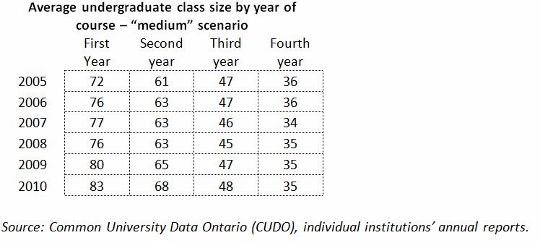As it goes with student-faculty ratios at Ontario universities, so it goes with class sizes. As the number of students relative to the number of faculty increases, class sizes get bigger. This has serious implications for the quality of higher education in our province – larger classes mean less student interaction with faculty, a key determinant of student engagement.
There are no data which make a comparison of class size possible between the late-1990s/early 2000s and the ‘double cohort’ period – where enrolment swelled due to the elimination of the OAC year. However, it appears that there was a slight improvement in class size once the double cohort completed their studies. Unfortunately, it appears that class sizes are once again on the rise.
Published data do not indicate the actual average size of classes by undergraduate year, but they do provide information on the number of classes by size range. Assuming a particular average class size for each range is no substitute for the actual data, but it can provide an indication of developing trends.
According to OCUFA’s “medium” class-size projection, it is clear that growth in first- and second-year class sizes has continued almost unabated since 2005. It is less obvious for the third and fourth year classes, but larger class sizes appear to be rippling outwards from the first and second years.
While worrying, these data are only estimates. Currently, accurate class size data is not available in Ontario. In order for students and their families to understand what is happening to learning quality, universities must be compelled to release accurate class size figures.

Note: The “medium” scenario assumes 29 students per class in the under 30 range; 45 in the 30-60 range; 80 in the 61-100 range; 150 in the 101-250 range; and 251 in the 250-plus range. The maximum for the smallest range offsets the minimum for the largest range, for which there can be no fixed median or mean by definition. The product of the assumed average number of students per class and the number of classes can be divided by the number of classes to yield an estimated average class size for each year of study.
This article originally appeared in the OCUFA Report. To receive stories like this every week in your inbox, please subscribe.




